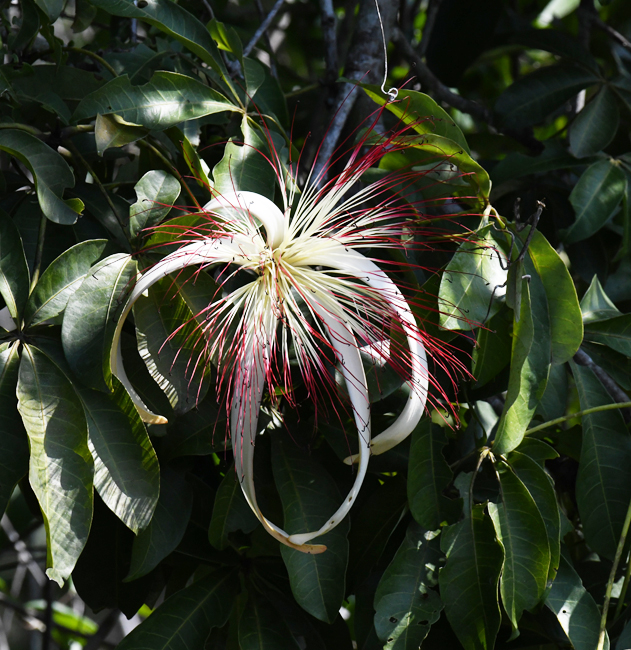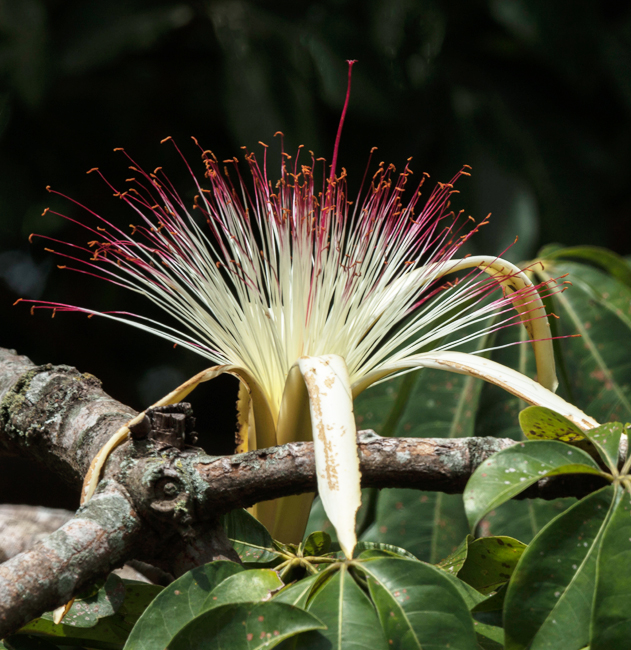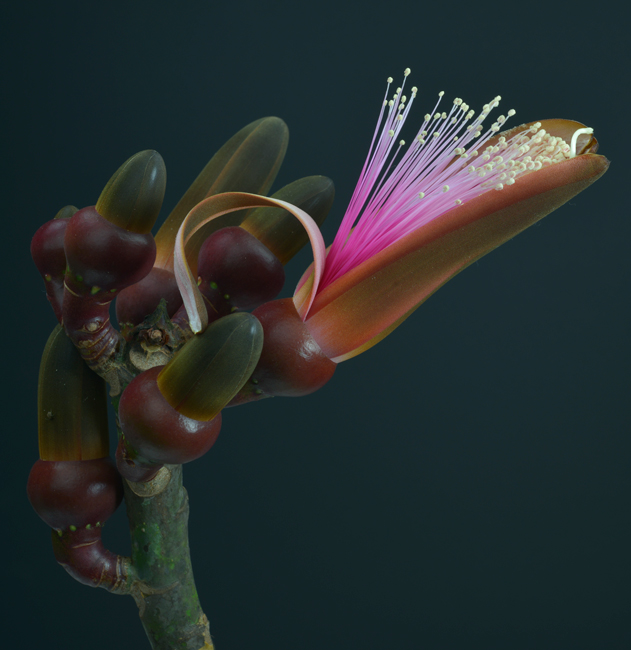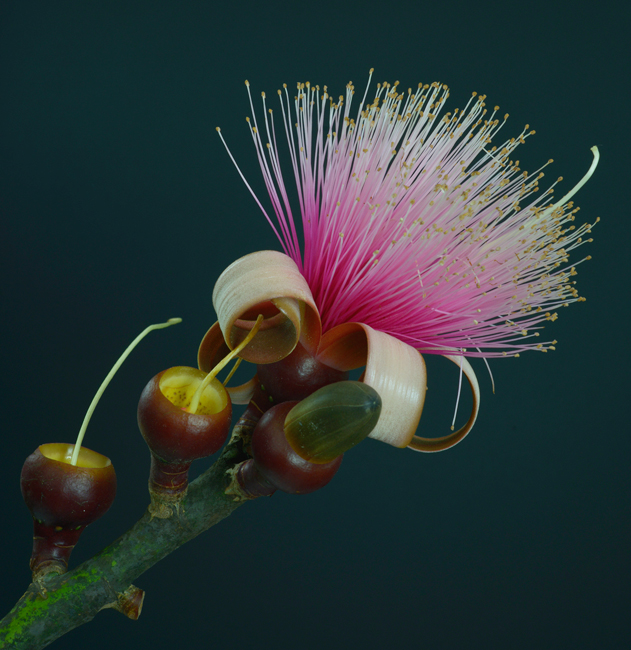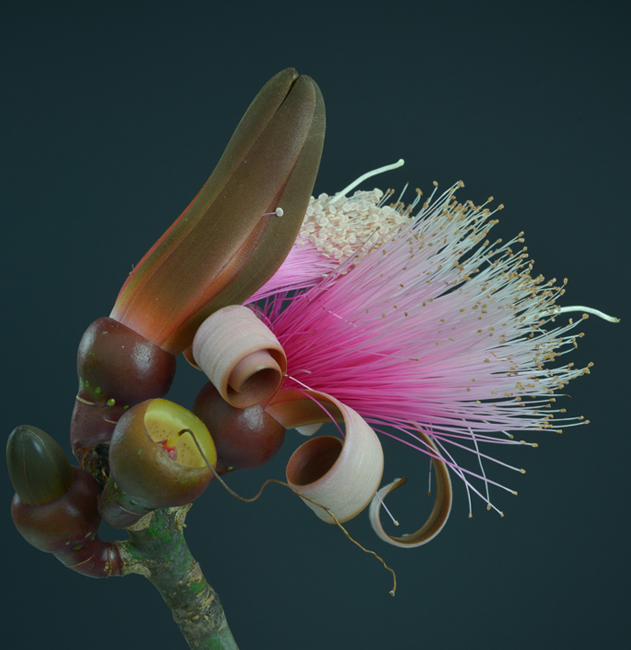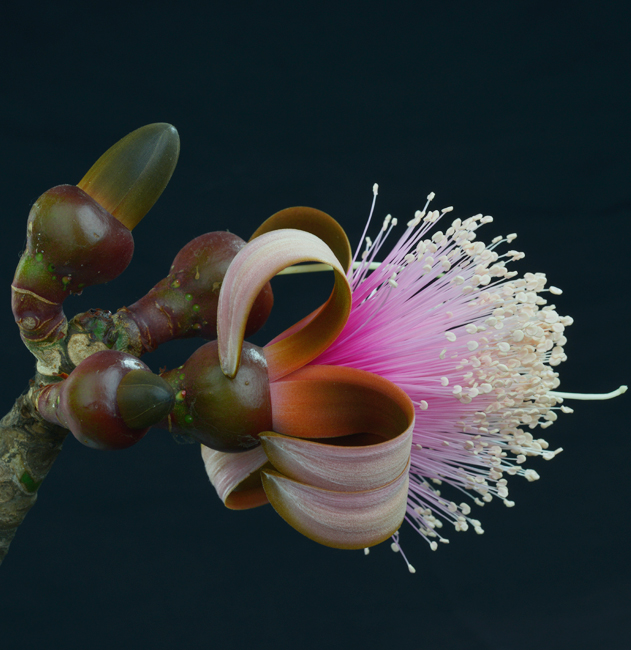Flowers of Pseudobombax ellipticum look like compact versions of flowers of Pachira aquatica
Since Pseudobombax ellipticum and Pachira aquatica are close relatives in the same plant family, it is no surprise that their flowers look similar. Plus, in a few areas of the Departamento of Izabal, they grow near each other. This we found along Canyon de Rio Dulce, Municipio de Livingston, during our field trips of 2020.
Flower of Pseudobombax ellipticum
Yet in Parque Nacional Yaxha, Nakum and Naranjo, during 2018-2019, we did not find a single Pachira aquatica within the park but found several Pseudobombax ellipticum trees, plus Ceiba pentandra trees (which are rare in Izabal).
Pseudobombax ellipticum flowers when there are no leaves on the tree
Most of the Pseudobombax ellipticum are showing their beautiful flowers when there are no leaves on the tree. Each tree produces only all white or all pink flowers. We found two all white trees and one all pink tree while driving up and down various highways in Guatemala (Guatemala to Chiquimulilla; then to Mazatenango then back to Escuintla and up the steep highway to Alotenango and Antigua. That Pseudobombax ellipticum have white flowers.
Pink flower of Pseudobombax ellipticum
We hope that botanists can ascertain whether the white-flowered Pseudobombax ellipticum are wild and native and the pink-flowered Pseudobombax ellipticum are a garden variety? Or are the pink ones more in the Highlands or more in dry areas; and the white ones more in moist areas such as Peten and Izabal.
Where are these trees?
We found one white species past Barberena (less than an hour from Guatemala City). Found another white one on the highway paralleling tributaries of the Rio los Esclavos. This highway goes to Chiquimulilla. The white Pseudobombax ellipticum was two meters from a Ceiba (had no flowers and no leaves; but probably not a Ceiba pentandra. This is because Ceiba pentandra were not blooming anywhere in Highland Guatemala or Rio Motagua area nor Izabal nor Verapaz in late December of early January.
Rio los Esclavos area has pine trees and in January already begins to look very dry. Yet alongside the rivers you see a diversity of trees that remind you of Peten or Verapaz. But I would classify the area is dry, albeit not as dry as the Motagua desert corridor area.
The pink tree was roughly same altitude as Barberena. Both were wetter than Rio los Esclavos areas. But not one of these trees was near a river (in the sense that their roots could in no way reach river water). Thus I was surprised to find them along Rio Dulce and tributaries in Municipio de Livingston, Departamento de Izabal, Guatemala.
Caution is suggested when identifying flowers in Maya art
Many years ago I showed an obvious Bombacaceae flower that was on a Maya ceramic bowl. Flower-focused ethnobotanist Charles Zidar went further and showed a series of comparable Bombacaceae flowers on other Classic Maya vases.
If you took all flowers in Maya headdresses and throne scenes that have been labeled by archaeologists or botanists as water lily, I would not be surprised if several turn out to be other flowers. Same with other flower “identifications.” So far Zidar is more accurate for the fleur de lis, but flowers in headdresses are not as easy to really identify.
Although I feel that the flowers of Pseudobombax ellipticum and Pachira aquatica, are present in vase paintings (which a large isolated fleur de lis), I would be hesitant to accept each and every other identification so far (when in a bowl, or headdress, or otherwise not fully detailed at large size).
Botanists transfer plants from one family to another
Earlier botanical publications tended to put the tree in the Bombacaceae family (after all, the flower is pretty similar to that of Pachira aquatica). Then botanists created a sub-family Bombacoideae within the Malvaceae family. But nowadays most web sites on the Internet today simply list Pseudobombax ellipticum as a member of the Malvaceae family.
I would be hesitant to eat, or use as medicine, any plant named amapola
The seeds of Pseudobombax ellipticum are listed as being edible, and flowers or leaves for use in making a tea (Argueta et al. 1994:120 as mentioned by Ratsch). The seeds of Pseudobombax ellipticum, can be consumed if toasted (Navarrete, p. 664). Yet one local name for Pseudobombax ellipticum is amapola. Ratsch lists 21 plants which carry the name amapola (1998 auf Deutsch, translated to English 2005). The point I wish to make, is that most likely the only reason some of these 21 plants have the name amapola is because there are chemicals in the plant that produce effects other than nutritional! But for the trees of Bombacaceae, I am not convinced whatsoever that they have hallucinogenic effects whatsoever. It would be helpful for linguists to study the word mapola and learn whether this is the original true correct name (and that amapola is more a joke; or maybe amapola has other meanings besides cocaine?). The Aztecs and their neighbors are infamous for their ingestion of plant drugs. There is a new book (published in Mexico, 2020 or 2021) that outlines substantial (excessive) drug use by the Classic Maya. But I do not believe that any tree of the Bombacaceae family produces hallucinogenic drugs.
Pseudobombax ellipticum has no spines on the trunk
This tree comes under consideration because of its remarkable flower. The tree trunk itself is not adorned with the remarkable spines of Ceiba pentrantra nor Ceiba aesculifolia. I do not accept the infrequent and relatively small occasional thorns of Pachira aquatica as showy enough to have been represented as thorns by the Classic Maya (though the flowers clearly were). However we have found a tree in Izabal that has conical thorns up and down its trunk comparable to a Ceiba pentandra.
Utilitarian aspects for Pseudobombax ellipticum
The Classic Maya did not have plastic, did not have metal processing (until Post Classic). So we have been accomplishing research for over a decade to make lists of all utilitarian plants of the Mayan areas.
The cotton-like kapok is used for pillows and mattresses. We will discuss other uses in our forthcoming full-scale report on Pseudobombax ellipticum.
Linguistics
x- cun che nel) pseudobombax ellipticum (h. b. et k.) dugand - bomba.: chac-kuyche, kuhche, kuyche, zac-kuyche, xcunche, xkuxche (amapola) -- mad., med.
(Bolles Yucatec Maya dictionary)
Unusual characteristics
If kept in a pot, and pruned, the plant base will grow into a shape with a surface similar to a turtle carapace (www.rareflora.com/bombaxellip.htm)
We also cover other trees of Bombacaceae:
Chiranthodendron pentadactylon
Introductory Bibliography on Pseudobombax ellipticum
- 2007
- Trees in the Life of the Maya World. BRIT PRESS, Botanical Research Institute of Texas. 206 pages.
Regina de Riojas has dedicated much of her life to trees of the Maya and trees of Guatemala. Elfriede de Pöll has likewise dedicated her life, to biology of Guatemala, at Universidad del Valle de Guatemala.
- 1994
- Atlas de las Plantas de la Medicina Tradicional Mexicana. 3 volumes. Instituto Nacional Indigenista, Mexico D.F.
- 2004
- Plants of the Peten Itza’ Maya. Museum of Anthropology, Memoirs, Number 38, University of Michigan. 248 pages.
Very helpful and nice collaboration with local Itza’ Maya people. But would help in the future to have a single index that has all Latin, Spanish, and English plant names so that you can find plants more easily.
Not available as a download.
- 2000
- Checklist of the Vascular Plants of Belize: With Common Names and Uses. Memoirs of the New York Botanical Garden Vol. 85. 246 pages.
- 2015
- Messages from the Gods: A Guide to the Useful Plants of Belize. The New York Botanical Garden, Oxford University Press.
- 2000
- A Biological Assessment of Laguna del Tigre National Park, Petén, Guatemala. RAP Bulletin of Biological Assessment 16, Conservation International, Washington, DC. 221 pages.
- n.d.
- Yucatec Maya dictionary. Available on-line.
- 2016
- Trees of La Milpa Identification of Trees in the La Milpa Area, Rio Bravo Conservation and Management Area, Belize.
Although the photographs are often informal, there are more photos and at a better size than 80% of botanical reports.
- 2005
- Biodiversidad del Estado de Tabasco. CONABIO, UNAM, Mexico. 370 pages.
- 2013
- La biodiversidad en Chiapas: Estudio de Estado. 2 volumes, Comisión Nacional para el Conocimiento y Uso de la Biodiversidad/Gobierno del Estado del Estado de Chiapas, Mexico.
- 2016
- The forest of the Lacandon Maya: an ethnobotanical guide. Springer. 334 pages.
Sold Online:
www.springer.com/la/book/9781461491101
- 1987
- EGUIARTE, Luis, MARTÍNEZ-Del Río, Carlos and Héctor ARITA
Available Online:
www.jstor.org/stable/2388462?seq=1
- 2004
- Estudio para la estimación de la oferta potencial de materia prima de bosques certificados de Guatemala. Ministerio de Agricultura, Ganadería y Alimentación (MAGA), Instituto Nacional de Bosques (INAB), Programa Forestal Nacional (pfn), Organización Internacional de las Maderas Tropicales (OIMT). 37 pages.
Available Online:
www.itto.int/files/itto_project_db_input/2775/Technical/PPD-64-02-R1-M-INFORME-FINAL-ESTUDIO-DE-LA-OFERTA.pdf
- 2010
- Prehistoric Human-Environment Interactions in the Southern Maya Lowlands: The Holmul Region Case Final Report to the National Science Foundation.
Figure 21 is a wonderful photograph; first, it is large enough (half page size). Second it is adequately exposed. But most important of all, this helpful photo shows lots of Acoelorrhaphe wrightii around what I estimate is a single Crescentia cujete tree.
- 2010
- Indicadores ecológicos de la zona riparia del río San Pedro, Tabasco, México. MS Thesis, El Colegio de la Frontera Sur. 131 pages.
Available Online:
https://ecosur.repositorioinstitucional.mx/jspui/bitstream/1017/1656/1/100000050585documento.pdf
- 2000
- Etnobotanica Maya: Origen y evolución de los Huertos Familiares de la Península de Yucatán, México.
- 1615
- Quatro Libros; De la naturaleza, y virtudes de las plantas, y animales que estan receuidos en el uso de medicina en la Nueva España, y la methodo, y correcion, y preparacion, que para administrallas se requiere con lo que el Doctor Francisco Hernandez escriuio en lengua Lantina. Mexico: en casa de la viuda de Diego Lopez Davalos. Sabin Microfiche Collection no. 31514.
Available Online:
http://alfama.sim.ucm.es/dioscorides/consulta_libro.asp?ref=B2176086X&idioma=0
- 1995
- Plant Records from Natural Forest Communities in the Bladen Nature Reserve, Maya Mountains, Belize. Caribbean Journal of Science, Vol. 31, No. 1-2, 30-48, College of Arts and Sciences University of Puerto Rico, Mayague.
Available Online:
www.researchgate.net/profile/Susan_Iremonger/publication/266581600_
Plant_Records_from_Natural_Forest_Communities_in_the_Bladen_Nature_
Reserve_Maya_Mountains_Belize/links/5632146708ae0530378e92bb.pdf
- 2011
- Árboles de México. Editorial Trillas. 368 pages.
- 1937
- The Vegetation of Peten. Carnegie Institution of Washington, Publ. 478. Washington. 244 pages.
- 1928
- Plants Probably Utilized by the Old Empire Maya of Peten and Adjacent Lowlands. Papers of the Michigan Academy of Sciences, Arts and Letters 24, Part I:37-59.
- 2011
- Estado actual y valor de uso etnobotánico de las especies vegetales utilizadas en la industria artesanal alfarera del municipio de Guatajiagua, Morazán El Salvador. Universidad de El Salvador. 54 pages.
Available Online:
http://ri.ues.edu.sv/8952/1/19200931.pdf
- 2002
- La vegetación de Calakmul, Campeche, México: Clasificación, descripción y distribución. Boletín de la Sociedad Botánica de México. 71: 7-32
Available Online:
www.botanicalsciences.com.mx/index.php/botanicalSciences/article/view/1660/1309
- 2003
- Plantas utiles de Peten, Guatemala. Herbario UVAL, Instituto de Investigaciones Universidad del Valle de Guatemala.
- 1987
- Fruits of warm climates. Julia F. Morton, Miami, FL.
- 2002
- Pseudobombax ellipticum (Junth) Dugand. In Tropical Tree Seed Manual, Part II, Species Descriptions, pages 664-665. US Forest Service. Available on-line RNGR.
- 2011
- Selective Logging and Regeneration of Timber Species in the Maya Biosphere Reserve in Guatemala. Journal of Sustainable Forestry Volume 30(8), pages 850-865.
Available Online:
www.researchgate.net/publication/254371010_Selective_Logging_and_
Regeneration_of_Timber_Species_in_the_Maya_Biosphere_Reserve_
in_Guatemala
- 2018
- Árboles de Calakmul. ECCOSUR, Chiapas. 245 pages.
It is amazing that there is no such book for Parque Nacional Tikal, nor El Mirador. Even though it includes only half the estimated number of “trees,” it has more tree species than Schulze and Whitacre for Tikal (they estimated about 200 but list only about 156 (their lists of species and list by plant family are not identical).
The entire book is a totally free download, however you can’t copy and paste so is difficult to add to your discussion.
Available Online:
http://aleph.ecosur.mx:8991/exlibris/aleph/a221/apachemedia/74R92GMRSJSEPFDEE5NJY4SJI2I8AK.pdf
- 2008
- Plantas vasculares y vegetación de la parte alta del Arroyo Agua Fría, municipio de Minatitlán, Colima, México. Act. Bot. Mex no.84 Pátzcuaro
Available Online:
www.scielo.org.mx/scielo.php?pid=S0187-71512008000300004&script=sci_arttext&tlng=pt
- 2008
- Trees of Guatemala. The Tree Press. 1033 pages.
- 2011
- Árboles del mundo maya. Natural History Museum Publications. 263 pages.
Helpful book; contributing authors are experienced botanists. They cover 220 species of trees, more than virtually all other “Books on Trees of the Maya.” Even include tasiste (which is missing from all other books on “Trees of the Maya” except for the recent book on Árboles de Calakmul.
But if all this effort is going into a book, would help if there were more photos, larger photos, and not so much blank space at the bottom of each page. Plus would help if the text could include personal first hand experience with these trees out in the Mundo Maya. But even as is, it is a helpful book.
If you are doing field work you need this, plus Árboles de Calakmul, plus Árboles tropicales de México. Parker’s book you need back in your office, since out in the field it’s not much help due to lack of photographs. Back in your office the books by Regina Aguirre de Riojas are also helpful.
- 2005
- Árboles tropicales de México. Manual para la identificación de las principals especies. 3rd edition. UNAM, Fondo de Cultura Economica. 523 pages.
This book is a serious botanical monograph. 1968 was the first edition (I still have this), 1998 was second edition. The 3rd edition is a “must have” book. Each tree has an excellent line drawing of leaves and often flowers and fruits (though to understand flowers you need them in photographs, in full color). Each tree has a map showing where found in Mexico (such maps are lacking in most books on Trees of Guatemala or plants of Belize). But trying to fit a description of a tree on one single page means that a lot of potential information on flowering time is not present. And, this is definitely not a book on ethnobotany: for that you need Suzanne Cook.
- 1993
- The Paradise Garden Murals of Malinalco: Utopia and Empire in. Sixteenth-Century Mexico. University of Texas Press. 224 pages.
- 2015
- Buenas prácticas para el manejo, manipulación y producción de madera en Petén Guatemala. Manual para la industria de la madera. Centro Agronómico Tropical de Investigación y Enseñanza (CATIE). División de Investigación y Desarrollo, Turrialba, Costa Rica.
Available Online:
https://docplayer.es/53831565-Buenas-practicas-para-el-manejo-manipulacion-y-produccion-de-madera-en-peten-guatemala-manual-para-la-industria-de-la-madera.html
- 1968
- Brosimum alicastrum as a Subsistence Al¬ternative for the Classic Maya of the Central Southern Lowlands. M.A. Thesis, Department of Anthropology, University of Pennsylvania, University Microfilms, Ann Arbor.
- 1973
- Ancient Maya Settlement Patterns and Environment at Tikal,
Guatemala. PhD dissertation, Anthropology, University of Pennsylvania.
Available Online:
www.puleston.org/writings-dissertation.html
- 2015
- Settlement and Subsistence in Tikal The assembled work of Dennis E. Puleston (Field research 1961-1972). Paris Monographs in America Archaeology 43, BAR International Series 2757. 187 pages.
This is his wife’s reorganization of his 1973 PhD. No tasiste, no nance could I find. Crescentia cujete is only mentioned as a usable plant, seemingly based on Lundell’s 1938 list rather than Puleston finding it in a savanna. In other words, there is no list in this Puleston opus that suggests he studied or made lists of savanna habitats. And there are no photographs of any savanna. Indeed the word savanna is not in his index. This is because the focus of all 1960’s-1970’s Maya field work was in traditional archaeology and in hilltop settlement areas. There were no house mounds in savannas so no interest (in those decades) in studying a savanna.
- 2005
- The Encyclopedia of Psychoactive Plants. Inner Traditions, Vermont. 942 pages.
Very helpful book, based on decades of in-person fieldwork and experience. But, as with any and every opus (including my own) there are occasional potential errors, such as identifying a twisted vine as a drug vine just because it is twisted around each other. I have decades of experience hiking the trails through Peten and Izabal; there are lots of twisted vines that have no relationship whatsoever to drug vines of South America. You should not identify a vine unless you have flower, leaf, or a local plant guide (who is not into hallucinogenics) identify the vine accurately (not just to make you happy by naming the plant what they know you want them to think it is)
- 1950-1982
- Florentine Codex: General history of the things of New Spain. 12 volumes. School of American Research, University of Utah.
Translated from the Nahuatl with notes by Arthur J. O. Anderson and Charles E. Dibble
- 2004
- Estudio morfológico de plántulas de la familia Bombacaceae en Quintana Roo, México. Foresta Veracruzana 6(2):1-6
Available Online:
www.redalyc.org/pdf/497/49760201.pdf
- 1999
- A Classification and Ordination of the Tree Community of Tikal National Park, Peten, Guatemala. Bulletin of the Florida Museum of Natural History. Vol. 41, No. 3, pp. 169-297.
Even though 20 years ago, it’s the best list of trees of Tikal that I have found. There is a web site with plants of Tikal but they are not separated into trees, vines, shrubs, etc., so harder to use. The new monograph on Arboles de Calakmul is better than anything available so far on Tikal (and the nice albeit short book by Felipe Lanza of decades back on trees of Tikal is neither available as a scanned PDF nor as a book on Amazon or ebay).
Free download on the Internet.
- 2000
- A rapid assessment of avifaunal diversity in aquatic habitats of Laguna del Tigre National Park, Petén, Guatemala. In: Bestelmeyer, B.T. and Alonso, L.E. (eds.). A Biological Assessment of Laguna del Tigre National Park, Petén, Guatemala, pp. 56-60. Conservation International.
- 1936
- The Forests and Flora of British Honduras. Field Museum of Natural History. Publication 350, Botanical Series Volume XII. 432 pages plus photographs.
- 1923
- Trees and Shrubs of Mexico. Contributions from the United States National Herbarium, Volume 23, Part 3. Smithsonian Institution.
In this one monograph the species are not listed in alphabetical order, so it’s a mental adventure finding the species you are looking for.
All monographs by Standley and co-authors can be easily found and downloaded. I would recommend finding the .pdf versions as they are easier to store, easier to copy, and easier to share with students and colleagues.
- 1949
- Flora of Guatemala. Fieldiana: Botany, Volume 24, Part VI, Chicago Natural History Museum.
- 2013
- Biodiversity in Forests of the Ancient Maya Lowlands and Genetic Variation in a Dominant Tree, Manilkara zapote: Ecological and Anthropogenic implications.
Free download, but unfortunately you can’t copy-and-paste anything. But the dissertation is helpful as is her subsequent field work and articles.
- 2012
- Análisis de la riqueza florística del bosque seco de la finca San Miguel, Municipio de Sanarate, El Progreso, Guatemala, C. A. Licenciatura thesis, Universidad de San Carlos de Guatemala.
Available Online:
www.repositorio.usac.edu.gt/6632/1/JUAN%20CARLOS%20VALDEZ%20
POR%C3%93N.pdf
- 2007
- Fichas ecológicas. Árboles maderables de Quintana Roo. Fondo Mixto de Fomento a la Investigación Cientifica y Tecnológica CONACYT-GOBIERNO DEL ESTADO DE QUINTANA ROO.
Available Online:
www.researchgate.net/profile/Hans_Vester/publication/280649375_
Fichas_ecologicas_de_arboles_maderables_de_Quintana_Roo/links/
55c0c56b08ae9289a09ba594.pdf
- 2002
- Homegardens of Maya Migrants in the District of Palenque (Chiapas/Mexico): Implications for Sustainable Rural Development. In: Stepp, J.R., Wyndham, F.S., and R.K. Zarger (eds.). Ethnobiology and Biocultural Diversity. Pp: 631 – 647. University of Georgia Press; Athens, Georgia
- 1972
- A Highland Maya People and their Habitat: The Natural History, Demography and Economy K´ekchi´ PhD dissertation. 475 pages.
His field work was near San Pedro Carcha, which is now a suburb of Coban, Alta Verapaz. The climate is moist due to moist clouds during many times of the year.
Available on the Internet.
- 1982
- Árboles del parque Deininger. Ministerio de Educación, El Salvador.
- 2009
- Sacred Giants: Depiction of Bombacoideae on Maya Ceramics in Mexico, Guatemala, and Belize. Economic Botany, 63(2), 2009, pp. 119–129.
Helpful web sites for any and all plants
There are several web sites that are helpful even though not of a university or botanical garden or government institute.
However most popular web sites are copy-and-paste (a polite way of saying that their authors do not work out in the field, or even in a botanical garden). Many of these web sites are click bait (they make money when you buy stuff in the advertisements that are all along the sides and in wide banners also. So we prefer to focus on web sites that have reliable information.
https://serv.biokic.asu.edu/neotrop/plantae/
Neotropical Flora data base. To start your search click on this page:
https://serv.biokic.asu.edu/neotrop/plantae/collections/harvestparams.php
http://legacy.tropicos.org/NameSearch.aspx?projectid=3
This is the main SEARCH page.
https://plantidtools.fieldmuseum.org/pt/rrc/5582
SEARCH page, but only for collection of the Field Museum herbarium, Chicago.
https://fieldguides.fieldmuseum.org/guides?category=37
These field guides are very helpful. Put in the Country (Guatemala) and you get eight photo albums.
http://enciclovida.mx
CONABIO. The video they show on their home page shows a wide range of flowers pollinators, a snake and animals. The videos of the insects are great.
www.kew.org/science/tropamerica/imagedatabase/index.html
Kew gardens in the UK is one of several botanical gardens that I have visited (also New York Botanical Gardens and Missouri Botanical Gardens (MOBOT), in St Louis. Also the botanical garden in Singapore and El Jardín Botánico, the open forest botanical garden in Guatemala City).
www.ThePlantList.org
This is the most reliable botanical web site to find synonyms. In the recent year, only one plant had more synonyms on another botanical web site.
Web sites specifically on Pseudobombax ellipticum
www.cicy.mx/sitios/flora%20digital/ficha_virtual.php?especie=1785
Information
http://enciclovida.mx/especies/163270-pseudobombax-ellipticum
General information, photos and map distribution
https://www.gbif.org/es/species/3152212
Photos and map distribution
http://herbanwmex.net/portal/taxa/index.php?taxon=97102&clid=3808
References
www.naturalista.mx/taxa/201454-Pseudobombax-ellipticum
Photos and map distribution
https://parquedemalaga.ddns.net/pseudobombax-ellipticum/
Information about the uses
http://siba.unam.mx/irekani/handle/123456789/3295?proyecto=Irekani
Information and photos
Video
The YouTube video that is available has misunderstandings totally of ceiba and ceibo. Focus issues should have been erased; The YouTube video shot in Florida is much better filmed and nicer to watch in all respects (plus has nice music).
Last Update May, 2021
Bibliography written by Vivian Hurtado and Dr Nicholas Hellmuth
First post, January 2021.


